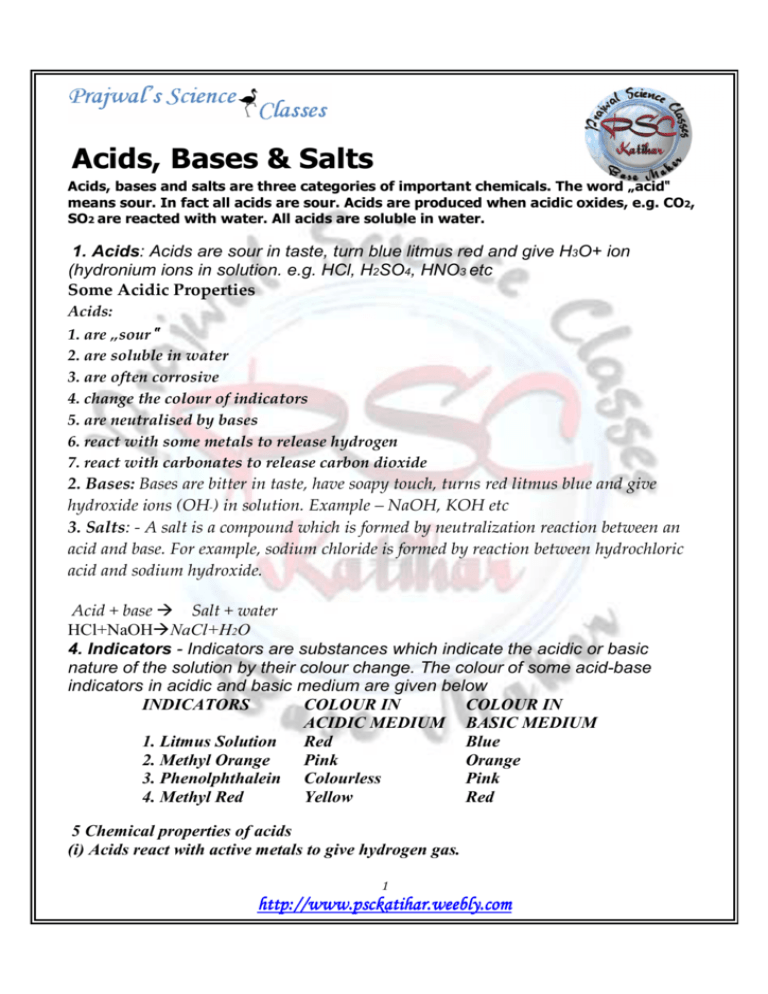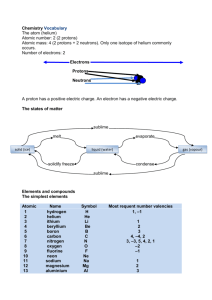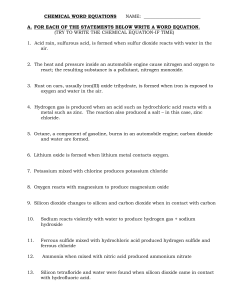File - Prajwal Science Classes
advertisement

Acids, Bases & Salts Acids, bases and salts are three categories of important chemicals. The word „acid‟‟ means sour. In fact all acids are sour. Acids are produced when acidic oxides, e.g. CO2, SO2 are reacted with water. All acids are soluble in water. 1. Acids: Acids are sour in taste, turn blue litmus red and give H3O+ ion (hydronium ions in solution. e.g. HCl, H2SO4, HNO3 etc Some Acidic Properties Acids: 1. are „sour‟ 2. are soluble in water 3. are often corrosive 4. change the colour of indicators 5. are neutralised by bases 6. react with some metals to release hydrogen 7. react with carbonates to release carbon dioxide 2. Bases: Bases are bitter in taste, have soapy touch, turns red litmus blue and give hydroxide ions (OH-) in solution. Example – NaOH, KOH etc 3. Salts: - A salt is a compound which is formed by neutralization reaction between an acid and base. For example, sodium chloride is formed by reaction between hydrochloric acid and sodium hydroxide. Acid + base Salt + water HCl+NaOH NaCl+H2O 4. Indicators - Indicators are substances which indicate the acidic or basic nature of the solution by their colour change. The colour of some acid-base indicators in acidic and basic medium are given below INDICATORS COLOUR IN COLOUR IN ACIDIC MEDIUM BASIC MEDIUM 1. Litmus Solution Red Blue 2. Methyl Orange Pink Orange 3. Phenolphthalein Colourless Pink 4. Methyl Red Yellow Red 5 Chemical properties of acids (i) Acids react with active metals to give hydrogen gas. 1 http://www.psckatihar.weebly.com Zn + H2SO4 ZnSO4 + H2 (ii) Acids react with metal carbonate and metals hydrogen carbonate to give carbon dioxide. NaHCO3+HCl NaCl + H2O+CO2 (iii) Acids react with bases to give salt and water. This reaction is called neutralization reaction. NaOH +HCl NaCl + H2O+CO2 (iv) Acids react with metals oxides to give salt and water. CuO + H2SO4 CuSO4 + H2O 6 Chemical properties of Bases1. Reaction with Metals – Certain metals such as Zinc, Aluminum, Tin react with Alkali solutions on heating and hydrogen gas is evolved 2NaOH + Zn → Na2ZnO2 + H2 2. Reaction with acids – Bases react with acids to form salt and water. KOH + HCl → KCl + H2O 3. Reaction with Non – metallic oxides – Non - metallic oxides are generally acidic in nature. They react with bases to form salt and water. 2NaOH + CO2 → Na2CO3 + H2O 7. Strong and Weak Acids An acid which completely dissociates into ions in aqueous solution is called strong acid such as HCl, H2SO4, and HNO3 etc. Weak acids are those which are weakly dissociated in its aqueous solution such as CH3COOH, H2CO3, and HCN etc. ] 8. Strong and Weak Bases A base such as NaOH or KOH which is completely dissociated in aqueous solution is called a strong base. On the other hand a base which is weakly dissociated such as NH4 OH in its aqueous solution is called a weak base. 9. pH Scale The concentration of hydrogen ions in solution is expressed in terms of pH. The pH of a solution is defined as the negative logarithm of hydrogen ion concentration in moles per litre. pH =-log [H+] pH =-log [H3O+] where [H+] or [H3O+] represents concentrations of hydrogen ions in solution. 2 http://www.psckatihar.weebly.com For water or neutral solutions, pH =7 For acidic solutions, pH< 7 For basic solutions, pH > 7 10. pH of Salts (a) pH of salts of strong acid – strong base such as NaCl=7 (b) pH of salts of strong acid – weak base such as CuSO4 is <7 (c) pH of salts of weak acid – and strong base such as CH3COONa >7 11. Some Important Chemical Compounds (a) Common Salt (NaCl) Sodium chloride is known as common salt .Its main source is sea water. It also exists in the form of rocks and sodium chloride obtained from rocks is called rock salt. Common salt is an important component of our food. It is also used for preparing sodium hydroxide, baking soda, washing soda etc. (b) Sodium Hydroxide or Caustic Soda (NaOH) Sodium hydroxide is prepared by passing electricity through an aqueous solution of sodium chloride (also known as brine). 2NaCl (aq) + 2H2O (l) 2NaOH (aq) + Cl2 (g) + H2 (g) This process is known as chlor -alkali process due to the formation of chlorine and sodium hydroxide (an alkali) as the products. Properties – 1. It is a white translucent solid. 2. It is readily soluble in water to give a strongly alkaline solution. 3. Crystals of sodium hydroxide are deliquescent. (c) Bleaching Powder (CaOCl2) Its chemical name is calcium oxychloride .It is prepared by passing chlorine gas through dry slaked lime. Ca (OH) 2 + Cl2 CaOCl2 + H2O Slaked lime Bleaching powder Uses1. For bleaching cotton and linen in textile industry. 2. For bleaching wood pulp in paper industry. 3. For disinfecting drinking water. (d) Baking soda (NaHCO3) Its chemical name is sodium hydrogen carbonate .It is prepared by passing CO2 gas through brine solution saturated with ammonia. NaCl + H2O + CO2 + NH3 -------------------- NH4Cl + NaHCO3 Ammonium chloride Sodium Hydrogen carbonate The precipitated sodium hydrogen carbonate is filtered off. Properties – 3 http://www.psckatihar.weebly.com 1. It is a white crystalline solid, sparingly soluble in water at room temperature. 2. Its aqueous solution is weakly alkaline due to hydrolysis. 3. On heating, it decomposes to give sodium carbonate and carbon dioxide. 2NaHCO3 Na2 CO3 + H2O + CO2 4. It reacts with acids to give CO2 gas. NaHCO3 + HCl NaCl + H2O + CO2 Uses1. It is used as a component of baking powder. In addition to sodium hydrogen carbonate baking soda contains tartaric acid. 2. It is used in soda- acid fire extinguisher. 3. It acts as mild antiseptic and antacid. (e) Washing soda (Na2 CO3 .10 H2O) Its chemical name is sodium carbonate decahydrate. It is obtained by heating baking soda in turn is obtained by passing CO2 gas through sodium chloride solution saturated with ammonia . NaCl + H2O + CO2 + NH3 ----------------------- NH4Cl + NaHCO3 2 NaHCO3 ---------- ------------------- Na2 CO3 + H2O + CO2 Sodium hydrogen carbonate Sodium Carbonate Recrystallisation of sodium carbonates gives washing soda. Na2 CO3 + 10 H2O Na2 CO3 .10 H2O Uses1. It is used in glass, soap and paper industries. 2. It is used for removing permanent hardness of water. 3. It can be used as a cleaning agent for domestic purposes. (f)Plaster of Paris (CaSO4 ..1/2 H2O) Its chemical name is calcium sulphate hemihydrate. It is obtained by heating Gypsum upto 373 K. CaSO4 .2H2O ----------- ----------CaSO4 ..1/2 H2O + 11/2 H2O Gypsum Plaster of Paris On treatment with water it is again converted into gypsum and sets as a hard mass. CaSO4 .2H2O CaSO4 ..1/2 H2O + 11/2 H2O ------------------Plaster of Paris Gypsum Uses – 1. It is used by Doctors for setting fractured bones. 2. It is used for making statues, models and other decorative materials. It is the oxonium ion that is the cause for acidic properties. 4 http://www.psckatihar.weebly.com + The basicity of acid is an indication of how many H ions are formed from one molecule of acid. Not all acids have the same strength. Note that strength does not have anything to do with concentration. „Concentrated‟‟ and „dilute‟‟ refer only to the proportion of water and acid in the solution. The strength of an acid depends on the concentration of H+ ions formed in solution. Strong acids produce a high concentration of H+ ions whereas weak acids produce a low H+ concentration in solution. Strong acids ionise completely when in solution, e.g. sulphuric acid. 5 http://www.psckatihar.weebly.com 6 http://www.psckatihar.weebly.com 7 http://www.psckatihar.weebly.com Water of crystallisation and associated terminology water incorporated in them. This water is called water of crystallisation. Salts that possess this water of crystallisation are called hydrates or as said to be hydrated. Salts which lose this water of crystallisation are called anhydrous. Some hydrates Name Most salts produce crystals that have Sodium carbonate crystals Sodium sulphate crystals Copper (II) sulphate crystals Iron (II) sulphate crystals Formula NaCO3.10H2O Na2SO4.10H2O CuSO4.5H2O FeSO4.7H2O When are acids not acids? A solution of hydrogen chloride (HCl) in water is acidic. But besides water, hydrogen chloride is also soluble in other solvents such as methylbenzene (C6H5.CH3) (also known as toluene). Hydrogen chloride does not behave the same in both solvents. Whereas in aqueous solution hydrogen chloride exhibits acidic properties, in methylbenzene it does not (or very little). Why is this so ? The answer to this behaviour of hydrogen chloride is obtained when one looks at the solvent. Water is a proton acceptor such that in water, hydrogen chloride is ionised, i.e. it forms ions. On the otherhand, methylbenzene is NOT a proton acceptor and in it hydrogen chloride is not ionised and remains mostly in the molecular state. In this state it does not exhibit any acidic properties since acidity depends on H+ ions. For the same reasons hydrogen chloride in water is a conductor of electricity whereas in methylbenzene it is not. Also, if ammonia gas is passed in a solution of hydrogen chloride in methylbenzene, a white precipitate of ammonium chloride is given. Everyday acids and alkalis Vinegar Vinegar is also known as acetic acid or more scientifically ethanoic acid. It is formed by the oxidation of ethanol, which is an alcohol. This also occurs as a natural process by bacterial action when they oxidise alcohol to form vinegar. This is why some wines often have a sour taste. Ethanoic acid is a typical organic acid. The characteristic group or functional group of organic acids is the COOH group. In fact the formula of ethanoic acid is CH3COOH. Vinegar is a weak acid because it does not ionise fully. CH3COOH(l) + H2O(l) CH3COO-(aq) + H3O+(aq) Bleach solution 8 http://www.psckatihar.weebly.com Bleaching powder is manufactured by passing chlorine over moist calcium hydroxide. It has a complex structure which can be simplified to „CaOCl2.H2O‟. Bleach solution is alkaline. It is also an oxidising agent and adds oxygen to whiten objects. Quicklime and slaked lime Quicklime or calcium oxide is a white solid. It does not melt easily, even at very high temperatures. It merely incandesces and gives out a powerful light. Once it was used for this purpose (lime-light). It is a base and in water it forms an alkaline solution called slaked lime, or calcium hydroxide. Slaked lime has several uses such as: to recover ammonia from ammonium chloride in the Solvay process; to to to to treat „acid‟ soils; make mortar which is used in building; soften temporary hard water; make bleaching powder; to make „milk of lime‟ which is used as whitewash. Prajwal Science Classes (BASE MAKER) IX – X CBSE (Mathematic Science)) (Mathematics ematics & Science Officer Colony Katihar Katihar 9122566868, 9031399488 9 http://www.psckatihar.weebly.com








